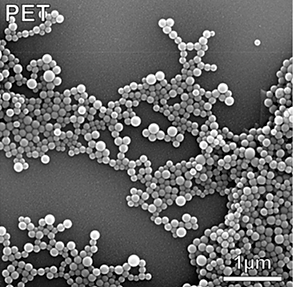top of page
Nanoplastics are tiny little particles smaller then 0.0001mm. They are not visible to the naked eye or even under a simple microscope. Current research studies have shown, that those particles can be taken up by animal and human cells.
Because of their commercial availability and simple synthesis polystyrene nanoplastics are widely used as model particles in studies regarding the effect of nanoplastic exposure on aquatic species and possible pathways to human exposure. However, the most common polymers found in the environment include polyethylene, polypropylene and PET. The lack of adequate study materials is a key issue that limits rapid advances within the research field.

0.001mm
The top-down approach
We demonstrated the creation of fluorescent nanoparticles made out of the polymers PET, polypropylene, and polystyrene by a top-down approach using a melt-process and milling techniques.
Plastic pellets with fluorophores
Cryo-milling
(< 0.3 mm)
Microplastics
Ball-milling
(< 0.0002 mm)
Fluorescent
Nanoplastics





We could show, that the nanoplastics we produced have sizes of less than 150 nanometers (0.00015 mm) and that they can be taken up by human intestinal cells and human immune cells.

Human intestinal cells with nanoplastics (red)

Human immune cells with nanoplastics (turquoise)
In conclusion, the presented melt-processing and milling methods resulted in heterogeneously shaped plastic nanoparticles with a fluorescence label allowing their behavior within a complex biological environment to be studied.
The bottom-up approach
Within this study, we created fluorescent nanoparticles made out of the polymers polyethylene, PET, polypropylene, and polystyrene by a bottom-up approach using an impinging jet mixing process.

Dissolved plastics will be mixed with an anti-solvent
The impinging jet mixing process
The different polymers are dissolved and injected together with an antisolvent into an impinging jet mixer. The nanoplastics produced have sizes of less than 100 nanometers (0.0001 mm) down to 30 nanometers and can be taken up by human immune cells.



Nanoplastics show sizes below 100 nanometers
In conclusion, the presented melt-processing and milling methods resulted in heterogeneously shaped plastic nanoparticles with a fluorescence label allowing their behavior within a complex biological environment to be studied.
bottom of page


